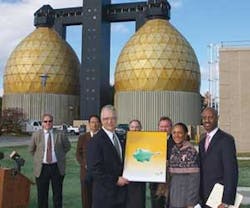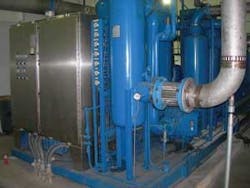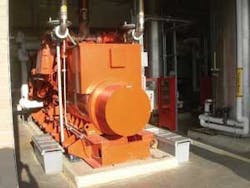Converting Wastewater Biogas into Renewable Energy
By Nicholas Frankos and Kari Pfisterer
Flames from the two flares leapt 20 feet into the cool morning air, as they burned off excess methane gas – a greenhouse gas many times more potent than CO2 – at the city’s Back River Wastewater Treatment Plant. Then, with the push of single button, the orange flames flickered for a few moments and then died, signaling the end of one era and the beginning of the next – an era of lower energy costs and cleaner air for the citizens of Baltimore.
On November 11, 2008, the mayor of Baltimore was the person who pushed that button, starting up a generator powered by the methane gas – a generator that will provide a significant portion of the Back River plant’s electricity needs, save taxpayers millions of dollars, and prevent millions of pounds of air pollutants from entering the atmosphere.
Back River Facility
Built almost a century ago, the Back River Wastewater Treatment plant stands on roughly 466 acres on the west bank of the Back River, a tributary that winds its way into nearby Chesapeake Bay.
The plant serves an estimated 1.3 million people who live in the 140 square mile Baltimore area. The Back River Plant operates around the clock with a staff of nearly 350 employees and can treat some 180 million gallons of wastewater every day.
The Back River plant has two Egg Shaped digesters and six in-ground digesters which has a total capacity of almost 14 million gallons. The biosolids are heated to 98 degrees F, using steam injection, and have a minimum 15 day detention time in the digesters. Biogas generated by the process has always been used to heat the campus and digestion process, but more gas was produced than could be used; so the excess was flared off to the atmosphere. This wasted excess biogas would become the potential fuel source for consideration in a cogeneration project.
Cogeneration Project
The City of Baltimore is known for its commitment to energy efficiency and sustainability. In 2006, the city entered into an energy savings performance contract for improvements at the Back River Wastewater Treatment Plant with Johnson Controls, a global provider of energy efficient systems.
In the preliminary analysis phase of the project, Johnson Controls determined that the Back River facility produced approximately 1.7 million cubic feet of methane gas per day. Of that, approximately 511,000 cubic feet were used to provide heat for the digestion process, and another 163,000 cubic feet were used to cool and heat buildings. The remaining roughly one-million cubic feet of excess methane gas was being burned off in flares.
The company determined the excess gas could be used to generate electricity that would reduce the amount of energy purchased to power the plant. In addition, waste heat from the electrical generation process could be used to further reduce the amount of energy used to produce heat in the plant. Total reductions in electricity demand were estimated at 19.4 million kilowatt hours.
To achieve these savings, Johnson Controls undertook the following facility improvement measures:
- Designed and installed gas conditioning equipment to remove impurities from the methane gas produced in the wastewater treatment process.
- Installed three 12-cylinder engine/generators, fueled by the excess methane gas. Each engine/generator is capable of producing 1,050 kW of electricity using a “lean burn” technology that results in reduced air emissions.
- Installed equipment to recover heat from the engine/generators and use it to produce hot water and steam for other plant operations.
- Upgraded digester recirculation pumps to improve their performance and efficiency.
- Made energy-efficient lighting improvements throughout the plant.
- Improved heating, ventilation and air conditioning systems in four major buildings.
- Upgraded plumbing fixtures to promote water conservation in five major buildings.
Johnson Controls will also provide ongoing day-to-day maintenance of the gas conditioning, engine/generators, heat recovery and other equipment installed under the contract.
Project Benefits
The performance contract with Johnson Controls guarantees costs savings from energy, operational, environmental and infrastructure improvements. The initial cost of the facility upgrades was approximately $14 million. But because the improvements will generate an estimated $18 million in cost savings, the project will ultimately pay for itself and allow Baltimore public officials to return additional savings to citizens in the form of lower utility bills.
The cogeneration facility and other improvements will reduce emissions of carbon dioxide by some 12.9 million pounds, and nitrogen oxide emissions by 7.7 million grams. Because the methane gas used as fuel in the engine/generators is pumped directly from its source into cogeneration facility, the plant’s energy security is improved.
Supplying 20 percent of the plant’s electricity needs with gas that was previously burned off acts as an excellent hedge against fluctuating energy prices. And because it reduces the amount of electricity utilities must generate, lower greenhouse gases emissions are the result. WW
About the Authors:
Nicholas Frankos is Plant Manager of the Back River WWTP. He has over 27 years of wastewater treatment experience with the City of Baltimore and received a BS from the University of Maryland in 1974 majoring in Environmental Sciences. Kari Pfisterer is manager of public relations for Johnson Controls.



